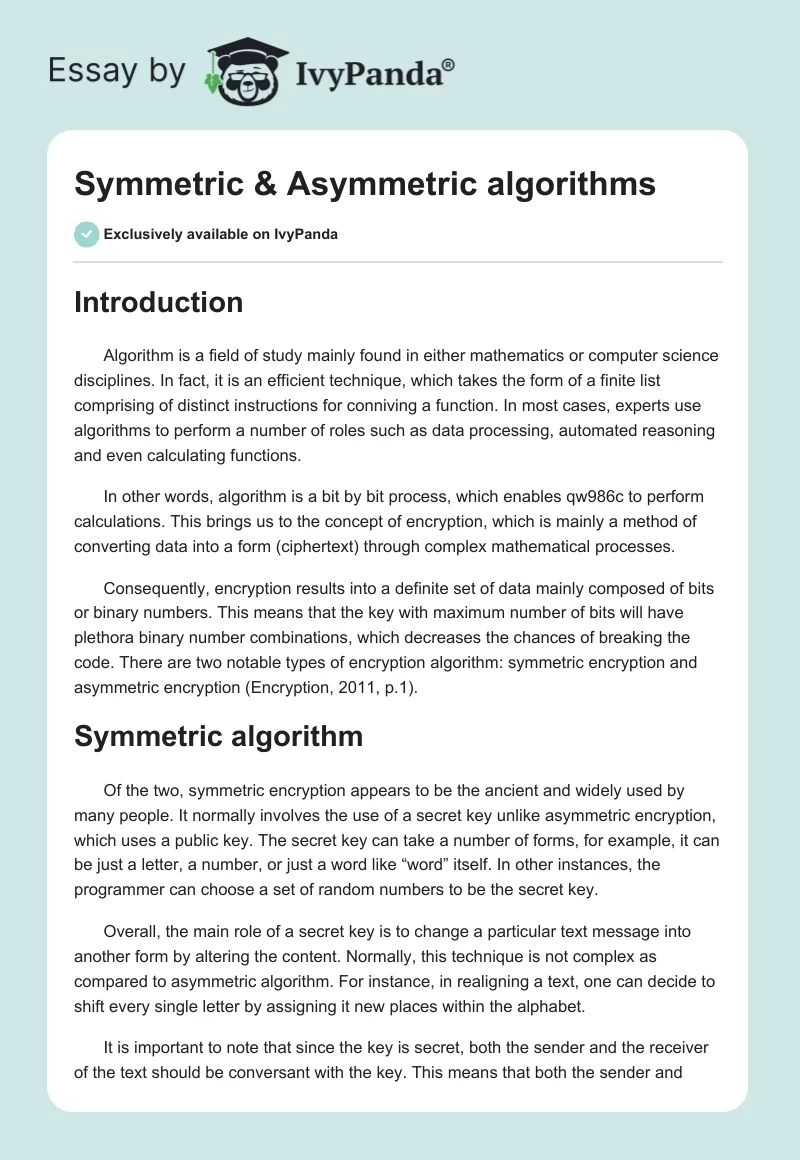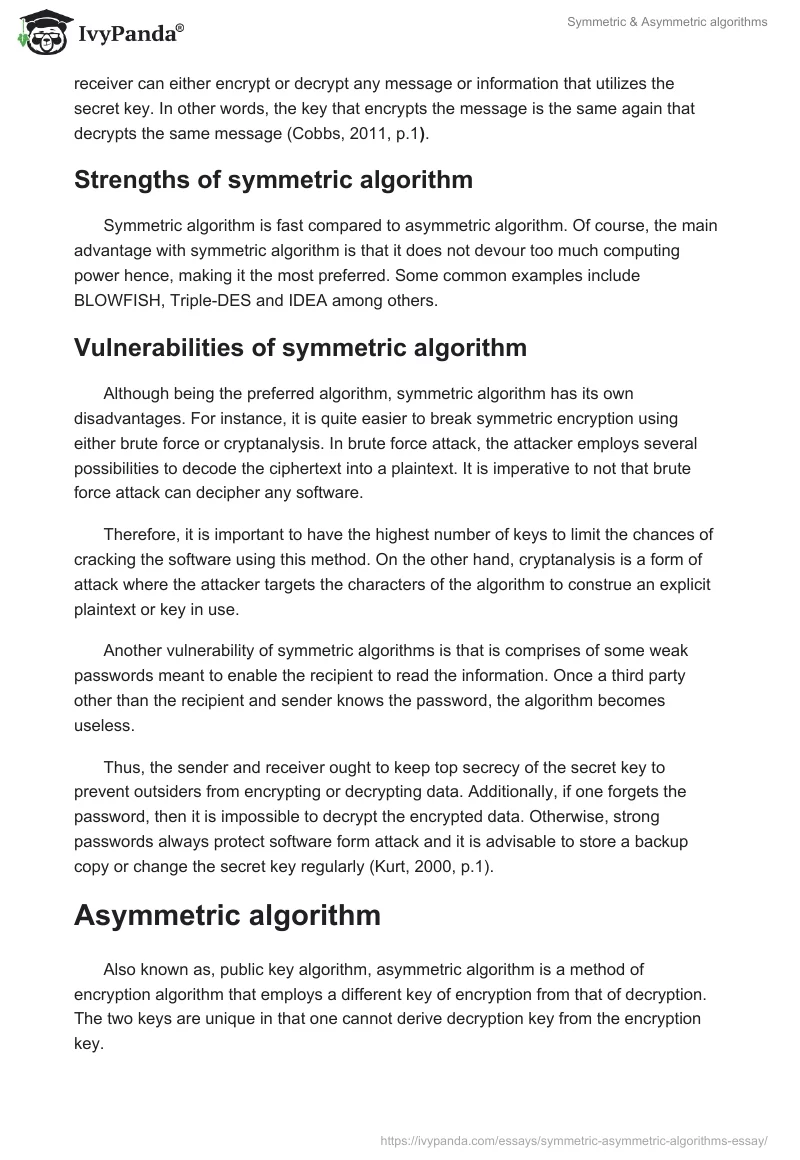Introduction
Algorithm is a field of study mainly found in either mathematics or computer science disciplines. In fact, it is an efficient technique, which takes the form of a finite list comprising of distinct instructions for conniving a function. In most cases, experts use algorithms to perform a number of roles such as data processing, automated reasoning and even calculating functions.
In other words, algorithm is a bit by bit process, which enables qw986c to perform calculations. This brings us to the concept of encryption, which is mainly a method of converting data into a form (ciphertext) through complex mathematical processes.
Consequently, encryption results into a definite set of data mainly composed of bits or binary numbers. This means that the key with maximum number of bits will have plethora binary number combinations, which decreases the chances of breaking the code. There are two notable types of encryption algorithm: symmetric encryption and asymmetric encryption (Encryption, 2011, p.1).
Symmetric algorithm
Of the two, symmetric encryption appears to be the ancient and widely used by many people. It normally involves the use of a secret key unlike asymmetric encryption, which uses a public key. The secret key can take a number of forms, for example, it can be just a letter, a number, or just a word like “word” itself. In other instances, the programmer can choose a set of random numbers to be the secret key.
Overall, the main role of a secret key is to change a particular text message into another form by altering the content. Normally, this technique is not complex as compared to asymmetric algorithm. For instance, in realigning a text, one can decide to shift every single letter by assigning it new places within the alphabet.
It is important to note that since the key is secret, both the sender and the receiver of the text should be conversant with the key. This means that both the sender and receiver can either encrypt or decrypt any message or information that utilizes the secret key. In other words, the key that encrypts the message is the same again that decrypts the same message (Cobbs, 2011, p.1).
Strengths of symmetric algorithm
Symmetric algorithm is fast compared to asymmetric algorithm. Of course, the main advantage with symmetric algorithm is that it does not devour too much computing power hence, making it the most preferred. Some common examples include BLOWFISH, Triple-DES and IDEA among others.
Vulnerabilities of symmetric algorithm
Although being the preferred algorithm, symmetric algorithm has its own disadvantages. For instance, it is quite easier to break symmetric encryption using either brute force or cryptanalysis. In brute force attack, the attacker employs several possibilities to decode the ciphertext into a plaintext. It is imperative to not that brute force attack can decipher any software.
Therefore, it is important to have the highest number of keys to limit the chances of cracking the software using this method. On the other hand, cryptanalysis is a form of attack where the attacker targets the characters of the algorithm to construe an explicit plaintext or key in use.
Another vulnerability of symmetric algorithms is that is comprises of some weak passwords meant to enable the recipient to read the information. Once a third party other than the recipient and sender knows the password, the algorithm becomes useless.
Thus, the sender and receiver ought to keep top secrecy of the secret key to prevent outsiders from encrypting or decrypting data. Additionally, if one forgets the password, then it is impossible to decrypt the encrypted data. Otherwise, strong passwords always protect software form attack and it is advisable to store a backup copy or change the secret key regularly (Kurt, 2000, p.1).
Asymmetric algorithm
Also known as, public key algorithm, asymmetric algorithm is a method of encryption algorithm that employs a different key of encryption from that of decryption. The two keys are unique in that one cannot derive decryption key from the encryption key.
While the encryption key is public, the decryption key is private and only the receiver of the message is able to decrypt it. In other words, the public that has the same software can send messages using the public key but only those with the private key can read the message (Christof & Jan, 2009, pp.3-7).
Strengths of asymmetric algorithm
Widely used in the electronic commerce industry (e.g. RSA asymmetric algorithm for SSL), asymmetric algorithm provides sufficient security as there is neither the sharing of the secret key nor the use of advanced executions.
Thus, there is minimal risk of third parties knowing the secret key and decrypting data. Additionally, the interdependency of the two key, that is, one for encrypting the message and the other for decrypting the same message is paramount in creating additional features such as digital signatures which not only guarantees the security of the message, but also, the authenticity or remote systems.
However, as compared to symmetric algorithm, asymmetric algorithm is slower since, data encryption normally involves the process of symmetric algorithm, and then using RSA, the short symmetric key is encrypted, thus, allowing the sending of decryption key to other parties together with the symmetrically encrypted data securely (Jevons, 1985, pp. 141-148).
Asymmetric algorithm vulnerabilities
Although this method is resistant to brute force attack, it is not lost that it enjoys security. For instance, the man-in-the-middle attack can tamper with the security of this type of algorithm by intercepting and altering the public keys when communication is in progress.
Nevertheless, as compared to symmetric algorithm, asymmetric algorithm is more resistant to security breach, and in addition, it warrants integrity and authentication (Public key cryptography, 2011, p.1).
Reference List
Christof, P. & Jan P. (2009). Introduction to Public-Key Cryptography. New York: Springer.
Cobbs, M. (2011). What are the differences between symmetric and asymmetric encryption algorithms? Web.
Encryption. (2011). Web.
Jevons, W. (1985). The Principles of Science: A Treatise on Logic and Scientific Method. New York: Dover Publications.
Kurt, G. (2000). Symmetric vs. asymmetric algorithms. Web.
Public key cryptography. (2011). Web.


